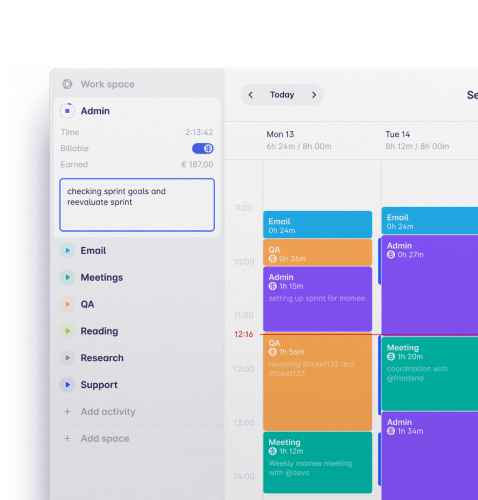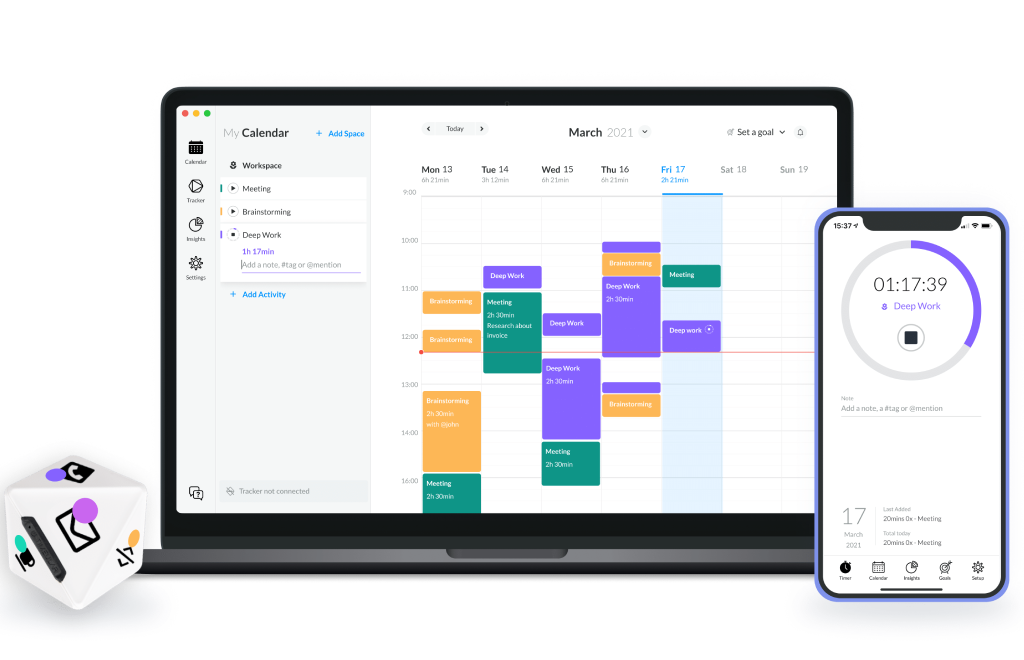How to Measure the Productivity of Employees [GUIDE]
Employees’ productivity determines what your company and team can achieve. Ultimately, it’s what determines if your business is successful or not.
As most people in leadership know, productivity is a frequent conversation topic, and everyone aims for the same outcome: increased productivity and success.
Most managers are already familiar with individual goals and performance reviews, but team productivity should also be measured to ensure you’re going in the right direction.

Maximize your team’s productivity with the help of time tracking
Tracking time together with your team helps to understand where your time goes
What is team productivity?
Team productivity is a measure used to observe how well the team performs. Productivity tracking is the same for the individual and done for the whole team simultaneously.
Contrary to what you may think, evaluating your team’s productivity is not that hard and similar to assessing your team members individually.
“Team productivity is a measure of activities performed for quality output in a specific amount of time. It also involves raising the satisfaction of team members and providing the necessary tools to perform the tasks with complete efficiency.” (Director Ehab Al-Hakawatii).
To put it simply, you must measure the quantity of work that was delivered by the team during a defined period or with a specified amount of effort. For example, try measuring the number of projects that were provided by your team for one month.
As a manager, you must track this metric monthly and compare the actual results with the set goals to understand the progress made.
But how can you measure productivity? How can you truly know if your team is being productive and if you will achieve your goals?
Read also: Ways to improve employee productivity

eBook: How to work smart, not hard
Learn how to teach your team how to work smart, not hard. Share the eBook with your team members and embrace a new approach to productivity!
How to measure the productivity of employees in the workplace
Accurately measuring and understanding employee productivity is one of the critical factors of job management. Depending on your team’s work, there are different ways to measure productivity.
By measuring your team’s productivity, you’re calculating how much work a team can produce over a given time, such as a month or a year. The team’s productivity depends on many factors, like KPIs or productivity levels of each employee, as well as their skills and knowledge.
Many other factors, such as team communication, work environment, company culture, and motivation levels, also profoundly impact how your team feels and produces.
Even though there are many practical methods you can use to track your team’s productivity, it is crucial to remember that every company and team is different. And it would be best if you found more effective ways to suit your workplace better.
Considering these differences, it is obvious that productivity measures will also be different.
So, if you’re a manager trying to measure your team’s productivity, ask yourself the following questions:
- What type of performance can you tag as productive?
- Is there a sales or production quota that a team must meet?
- What are the most important goals of each team?
Even though there are many ways you can track your team’s productivity, let’s see how you can do it.

1. Time management at work
Time management is the process of organizing, managing, and prioritizing your time. Effective time management means you take control of your time and energy, both professionally and personally.
Time management aims to maximize your time on specific tasks or projects that help you achieve your goals faster and focus on what matters instead of unimportant work.
Whatever the size of your business, you can monitor the productivity of your workers based on their time management.
Some smaller tasks, such as checking e-mail, may not be considered important enough to be tracked. However, numbers show the exact opposite.
According to a McKinsey Global Institute Analysis study, on average, 28% of work time is spent on email, we check email on average 11 times per hour, and 84% keep email open in the background while working.
Summing up that time, can you imagine in a year how many hours are spent on e-mails and never tracked and, therefore, never accounted for? As a manager, you can use that information to define specific times for email use and ensure that no too much time is spent there.
Read our article to discover why time management training is important for your team.

How time tracking facilitates time management
To improve your time management skills, you can add time-tracking to your routine.
It’s one of the most important things every team should do to be successful. Time-tracking apps automate timesheets and make the whole process more accurate and fun.

Track productivity with Timeular – the most user-friendly time tracking tool you will find
“Timeular is a simple solution which has a huge positive impact on my productivity. Using Timeular has helped me feel more confident as it makes it clear to me what I’m actually achieving with my time” – Jenny Blackett, a software engineer
To better know where your time is going every day and if you’re using it effectively, time tracking has become more critical for businesses that wish to be as efficient as possible, especially now that many companies work remotely or hybrid.
Time tracking is essential to boosting your employee’s productivity and getting crucial information to keep your projects running smoothly.
By using a time and productivity tracking tool, you can be more effective and organized by ensuring greater accountability.
To accurately determine employee productivity, you need to know how much time was spent producing output, and you need to know as precisely as possible.
2. Quality vs. Quantity
You probably already heard the quote by Steve Jobs “Quality is more important than quantity. One home run is much better than two doubles.”
According to the dictionary, quality is “how good or bad something is”, meaning quality is a measure of excellence.
On the other hand, quantity is “the amount or number of something, especially that can be measured”, meaning quantity is the extent, size, or sum of something. It’s countable or measurable and can be expressed as a numerical value. But how does all this fit into work?

eBook: How to boost your team’s productivity
Learn how to teach your team how to work smart, not hard. Share the eBook with your team members and embrace a new approach to productivity!
When managers talk about productivity, what they’re generally discussing is quantity, which is the output employees produce. However, what they do not discuss enough many times is the quality. That is the biggest difference between manual work and knowledge work, that which we referred to previously.
Generally speaking, we can say that manual workers care about quantity, whereas knowledge workers must care about both quantity and quality.
As a knowledge worker, you’re expected to deliver a large number of projects, not only in quantity but they are also supposed to benefit your company, therefore they must be very good and well-thought. There would be no point in delivering many projects, but none of them work.
Read our blog and get to know the differences between productivity and efficiency.

3. KPIs and goals
To determine whether your team is productive, you can compare what your employees have done about the work goals you set for them as individuals and as a team.
Check your team’s productivity by looking at their goals and those they failed to achieve. This is one of the reasons why setting goals is essential to your team; it’ll allow you to compare expected vs. actual performance.
If your team fails to reach its goals consistently, it does not mean forcing them to work more hours is the right way.
The amount of time someone spends at work is not the same as the number of hours they’re working. Along that line, employees who put in long hours are not necessarily more productive than workers who log less time on the clock.
Employees who are more familiar with their goals are proven to be more productive than employees who are less informed on that topic.
Employees feel a deeper connection with their company and have a greater sense of purpose and belonging when they know what is expected from them.
Increasing your team’s productivity may be as simple as reminding them about your organization’s goals and breaking the achievement of those objectives into smaller tasks.
TIP: Use one of the top employee time tracking apps to measure the productivity of your employees to increase business efficiency and revenue.
4. Performance tracking
Tracking your employee’s performance can help you measure how productive your workers are. Performance tracking involves more factors than goals and is much easier to gauge.
For instance, it accounts for whether your employees show up on time, have a good relationship with their peers, and contribute to the organization’s culture.

5. Planned-to-done ratios
The planned-to-done ratio measures the percentage of tasks that were completed to those that were assigned.
By analyzing your employee performance against a given list of tasks, you will get some deep insights into your team’s capacity and potential for productivity.
A time-tracking software, such as Timeular, is an excellent tool for getting this information.
Let’s suppose your team has a lot of work in the pipeline. Your team must complete ten tasks monthly to deal with the deadlines and given objectives. However, if they could only meet five of those tasks a month, the planned-to-done ratio is 50%.
However, if you have a low planned-to-done ratio, it may be time for you to hire more team members to complete the workload, reduce the amount of work your team takes up, or rework your planning process to make it more efficient.
The benefits of gauging your team’s productivity
A study from SHRM shows 95% of managers are unhappy with how their company conducts performance reviews.
This frustration has led to some companies altogether abandoning annual reviews. However, it’s crucial that managers really understand the importance of it and how it can benefit both the employee and the company.
Here’s a list of the four most significant benefits of measuring your team’s performance and productivity.

1. Enables employee growth and development
Managers who don’t accurately and carefully measure their employee’s performance will be out of touch with their teams’ successes and failures.
This makes it impossible to provide constructive feedback and get results. Without valuable feedback, employees will be less able to improve, grow, and develop, and that will make them move on.
To be a great leader, increase employee satisfaction, and enable people to grow within their roles continuously, constructive feedback on their performance is critical.
According to a study from HBR.org giving and receiving feedback, 92% of the respondents agreed with the assertion, “Negative (redirecting) feedback, if delivered appropriately, is effective at improving performance.”
The truth is that people want to know how they’re doing to know how they can grow. Accurately measuring employee performance helps you deliver accurate, targeted, specific feedback if it’s done right.

2. Create goal alignment
Working with no specific goal in mind is dull. Everyone working with no particular purpose ends up feeling frustrated and unmotivated.
Employees do perform better when they have goals to strive for and work towards.
Measuring employee performance will allow any manager to adjust and regulate those goals by providing insight into whether someone is doing well.
However, goal setting must be a conversation about what the company needs and what the employee can contribute, not set only by managers with no employee input.
When goals are set without employee input or performance data, they can be too ambitious and won’t allow the company to grow. Also, it can burn out people and make them feel unmotivated.
On the other hand, when employees have goals that are too easy, the company needs to tap into their full potential.
So, if you’re leading a team or want to build a high-performing team, you should regularly measure employee performance and meet with employees about their projects, goals, and ambitions.
This way, they are less likely to be confronted with burnt-out or disengaged teams and more likely to have employees who meet the team and organizational goals.
3. Cost reductions
When you accurately track your time and measure your team’s productivity, you have a better sense of where you should invest.
What is making your company lose money? When you calculate productivity using the output ratio and the money you invested in the production process, you can identify things that require a more significant or minor investment.
By analyzing all the information, you might be surprised by how much money you can save by tracking and comparing productivity metrics over time or smartly investing elsewhere. This is one of the smartest ways to improve business efficiency.
4. Create a fair culture of recognition
Sadly, many companies don’t pay much attention to this. If you accurately measure your team’s performance, you also accurately compensate employees with promotions, internal role changes, terminations, whatever the case may be.
By analyzing every employee’s performance, you can ensure that you fairly compensate top performers by giving them the recognition they deserve and supporting your low performers.
Improving individual performance helps employees contribute to the company’s success, but it also helps with employee morale and motivation.
When employees think that low performers are tolerated without consequences, it can cause frustration and a bad environment.
Read our blog and find the best ways to keep your team motivated to be more productive
Conclusion
We all know different teams perform different tasks within a company, so it is impossible to evaluate their productivity with the same criteria.
For example, what makes a marketing team successful will differ from what you expect from a software development team.
Also, some standards might also differ if your team is working in the office full-time or remotely. However, understanding how well your employees perform is essential for evaluating your business development and improving results.
This article gave you some of what we believe are the most important aspects to consider when measuring your team’s performance and productivity and making the whole process much easier.
You might be interested in: